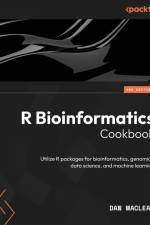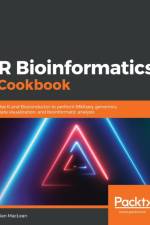av Dan Maclean
561
Discover over 80 recipes for modeling and handling real-life biological data using modern libraries from the R ecosystemKey Features:Apply modern R packages to process biological data using real-world examplesRepresent biological data with advanced visualizations and workflows suitable for research and publicationsSolve real-world bioinformatics problems such as transcriptomics, genomics, and phylogeneticsPurchase of the print or Kindle book includes a free PDF eBookBook Description:The updated second edition of R Bioinformatics Cookbook takes a recipe-based approach to show you how to conduct practical research and analysis in computational biology with R. You'll learn how to create a useful and modular R working environment, along with loading, cleaning, and analyzing data using the most up-to-date Bioconductor, ggplot2, and tidyverse tools.This book will walk you through the Bioconductor tools necessary for you to understand and carry out protocols in RNA-seq and ChIP-seq, phylogenetics, genomics, gene search, gene annotation, statistical analysis, and sequence analysis. As you advance, you'll find out how to use Quarto to create data-rich reports, presentations, and websites, as well as get a clear understanding of how machine learning techniques can be applied in the bioinformatics domain. The concluding chapters will help you develop proficiency in key skills, such as gene annotation analysis and functional programming in purrr and base R. Finally, you'll discover how to use the latest AI tools, including ChatGPT, to generate, edit, and understand R code and draft workflows for complex analyses.By the end of this book, you'll have gained a solid understanding of the skills and techniques needed to become a bioinformatics specialist and efficiently work with large and complex bioinformatics datasets.What You Will Learn:Set up a working environment for bioinformatics analysis with RImport, clean, and organize bioinformatics data using tidyrCreate publication-quality plots, reports, and presentations using ggplot2 and QuartoAnalyze RNA-seq, ChIP-seq, genomics, and next-generation genetics with BioconductorSearch for genes and proteins by performing phylogenetics and gene annotationApply ML techniques to bioinformatics data using mlr3Streamline programmatic work using iterators and functional tools in the base R and purrr packagesUse ChatGPT to create, annotate, and debug code and workflowsWho this book is for:This book is for bioinformaticians, data analysts, researchers, and R developers who want to address intermediate-to-advanced biological and bioinformatics problems by learning via a recipe-based approach. Working knowledge of the R programming language and basic knowledge of bioinformatics are prerequisites.




